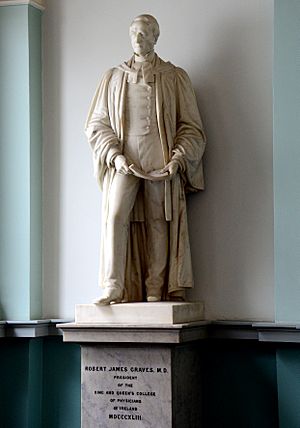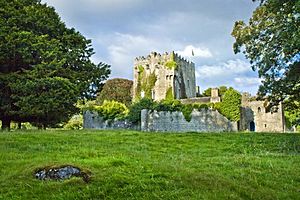Robert James Graves facts for kids
Robert James Graves (born March 27, 1796 – died March 20, 1853) was a very famous Irish doctor. He was a surgeon, which is a doctor who performs operations. A disease called Graves' disease is named after him. He was also the President of the Royal College of Physicians of Ireland, a member of the Royal Society of London, and he helped start the Dublin Journal of Medical Science. Interestingly, he also came up with the idea for the second hand on watches, though he never officially got credit for it.
Quick facts for kids
Robert James Graves
|
|
|---|---|
 |
|
| President of the Royal College of Physicians of Ireland | |
| In office 1843–1849 |
|
| Preceded by | Sir Henry Marsh, 1st Baronet |
| Succeeded by | William Stokes |
| Personal details | |
| Born | 27 March 1796 Holles Street, Dublin |
| Died | 20 March 1853 (aged 56) Cloghan Castle, County Offaly |
| Nationality | Anglo-Irish |
| Alma mater | Trinity College Dublin |
Contents
Early Life and Adventures
Robert James Graves was born in Dublin on March 27, 1796. He was the eighth child in his family. He went to school in Downpatrick and Dublin before attending Trinity College Dublin.
After studying hard and doing very well, he earned a degree in medicine in 1818. He then traveled around Europe for three years. He visited many important medical schools in cities like Edinburgh, Berlin, and Vienna.
Graves was very good at learning languages. Once, while walking in Austria without his passport, he was arrested. The police thought he was a German spy because he spoke their language so well! They couldn't believe an Irishman could be so fluent.
During his travels, he met the famous painter Joseph Mallord William Turner in the Swiss Alps. They traveled and sketched together for several months. Later, on a ship from Genoa to Sicily, Graves showed great bravery. A storm hit, the ship started leaking, and the crew wanted to abandon it. Graves famously took an axe and chopped a hole in the only lifeboat, telling the crew, "Let us all be drowned together, it is a pity to part good company." He then fixed the pumps using leather from his own shoes, saving everyone on board.
A New Way to Teach Medicine
When Graves returned to Dublin in 1821, he started his own medical practice. He brought new ways of teaching medicine to the Meath Hospital and the Park Street School of Medicine, which he helped create.
One of his most important ideas was "bedside teaching." This meant that students would learn directly from patients in the hospital. Instead of just listening to lectures, students would examine patients themselves. They would discuss cases with their teachers, learning how to figure out what was wrong and how to treat it.
Graves believed that simply watching a doctor was not enough. He wanted students to get hands-on experience. He said that students "must examine patients for themselves under the guidance of their teachers." This method made the Dublin School of Medicine very famous around the world.
Graves was a great teacher. He was tall and energetic, and he gave his lectures in English. At that time, many professors still taught in Latin. He told his students that from the very beginning, they should observe sickness every day.
He became a professor at the Irish College of Physicians. His "Clinical Lectures," published in 1843, made him well-known across Europe. He was also the president of the Royal College of Physicians of Ireland in 1843 and 1844.
Important Medical Ideas
Graves introduced several important ideas in medicine. He taught doctors to time a patient's pulse using a watch. He also changed the way patients with fever were treated. Before him, it was common to withhold food and liquids from feverish patients. Graves, however, insisted on giving them nourishment. He once joked to his student, William Stokes, "Lest when I am gone you may be at a loss for an epitaph for me, let me give you one – He Fed Fevers."
He also stressed the importance of research, telling his students to "learn the duty as well as taste the pleasure of original work." He kept in touch with his former students all over the world.
Graves was known for his sharp wit. When a colleague criticized the stethoscope (a tool doctors use to listen to hearts and lungs), Graves joked that the doctor's hearing must be bad.
Because of his great work in teaching, Graves was named a special professor at Trinity College. He also helped edit the Dublin Journal of Medical and Chemical Science. His most lasting fame comes from his "Clinical Lectures," which were highly respected. A French doctor, Armand Trousseau, even suggested the name "Graves' disease" for the condition Graves described.
Family Life
Robert James Graves was married three times. His first two wives and their infant daughters sadly passed away. In 1830, he married his third wife, Anna. They had six children together. One of his granddaughters later married a cousin of the famous playwright John Millington Synge. His eldest son, William Grogan Graves, later became the High Sheriff of King's County.
Later Life and Legacy
Graves lived in a townhouse in Dublin but died at his country home on March 20, 1853, just before his 57th birthday. He passed away from liver disease. The year before he died, his wife convinced him to buy Cloghan Castle in County Offaly. His grandson later sold the castle in 1908.
Robert James Graves was buried in Mount Jerome Cemetery in Dublin. He left his large library, which was worth a lot of money, to Trinity College Dublin. After he died, a Dublin company started selling watches with second hands, using an idea Graves had come up with for himself but never patented. His friend and fellow doctor, William Stokes, later published a collection of Graves' papers and a biography.


